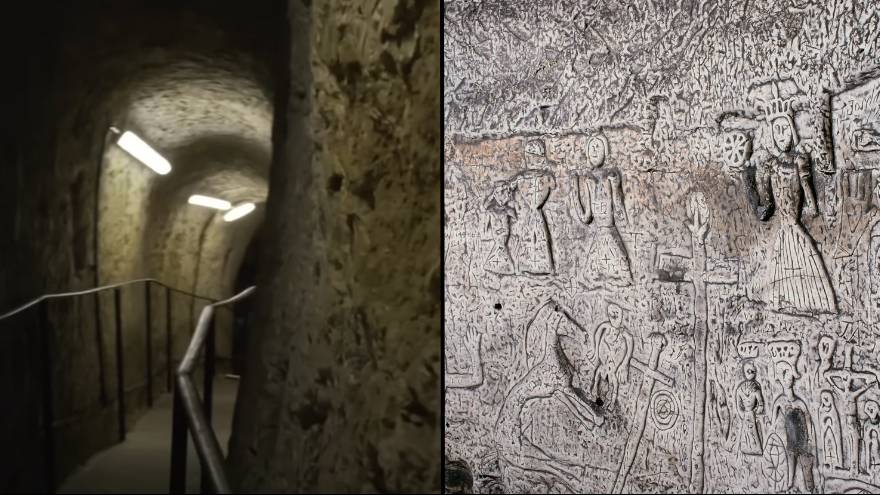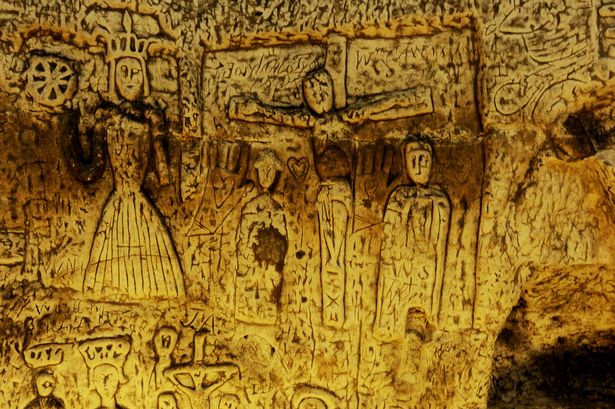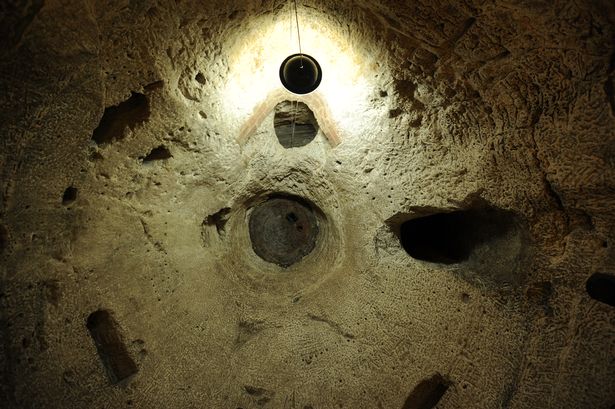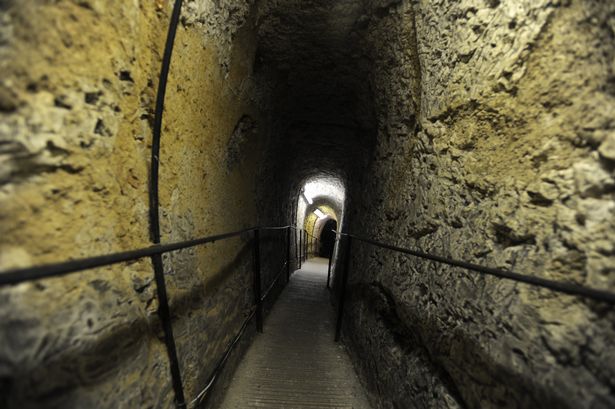Unexplained Underground Cave Discovered Under Hertfordshire Town Streets
Royston, a tranquil town nestled in rural Hertfordshire, guards a bewitching secret beneath its surface—an underground cave discovered under Hertfordshire town streets left both locals and historians puzzled for centuries. Known as Royston Cave, this circular chamber, carved meticulously out of chalky bedrock beneath the town's streets, continues to captivate the imagination with its enigmatic nature.
Author:Xander OddityReviewer:Dr. Felix ChaosphereJul 10, 20235.7K Shares96.5K Views
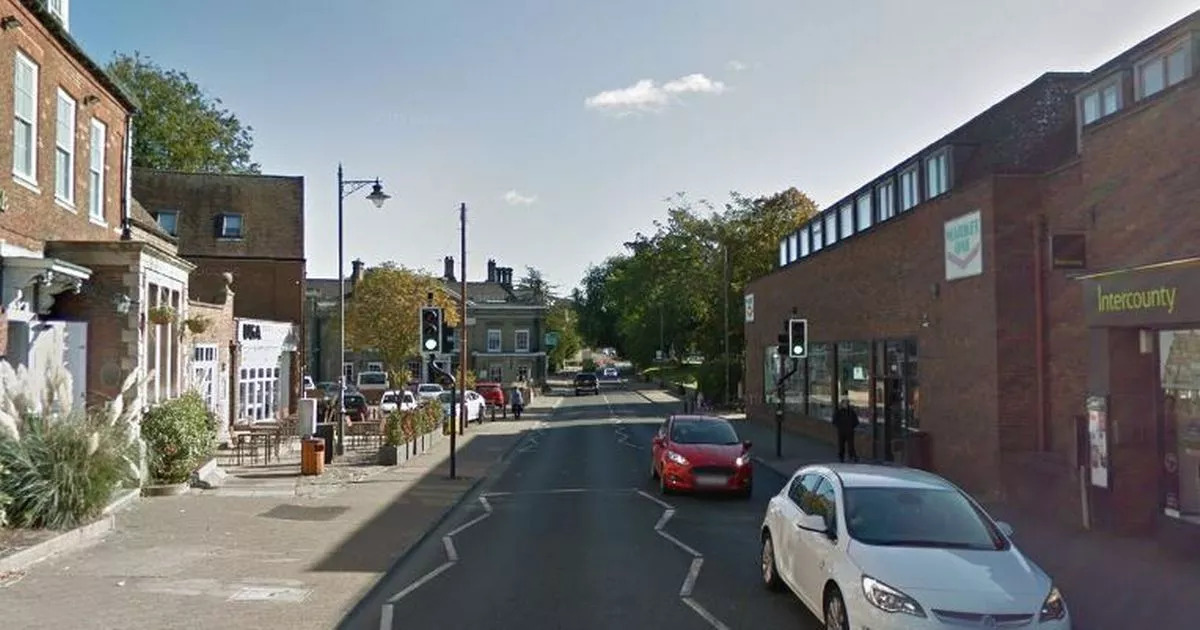
Royston, a tranquil town nestled in rural Hertfordshire, guards a bewitching secret beneath its surface—an underground cave discovered under Hertfordshire town streetsleft both locals and historians puzzled for centuries. Known as Royston Cave, this circular chamber, carved meticulously out of chalky bedrock beneath the town's streets, continues to captivate the imagination with its enigmatic nature.
Underground Cave Discovered Under Hertfordshire Town Streets
At a staggering five meters in diameter and eight meters tall, Royston Cave showcases an astonishing array of intricate carvings that adorn its walls. These carvings, representing a multitude of faiths, transform the cave into a treasure trove of religious iconography and symbolism.
Despite being discovered hundreds of years ago, the purpose of Royston Cave remains an enduring mystery. Visitors to the area have the unique opportunity to explore this extraordinary underground marvel, as it opens its doors on weekends and bank holidays during the summer months. Royston Cave invites curious souls to witness its grandeur and form their own interpretations of its significance.
The cave's carvings span a diverse range of subjects, encompassing iconic figures such as Jesus Christ and his disciples, Richard the Lionheart, and even King David from the Old Testament. These depictions offer a glimpse into the artistic prowess and historical significance of the cave's creators.
The origins of Royston Cave are believed to be the handiwork of skilled artisans, although the specifics remain elusive. One prevailing theory suggests that the cave served as a clandestine meeting place for the Knights Templar, a renowned Christian military order that flourished during the Middle Ages. Alternatively, some speculate that the cave may have been associated with the enigmatic Freemasons, known for their secretive rituals and symbolism. However, with no definitive records to support these theories, the truth behind Royston Cave remains veiled in uncertainty.
The accidental discovery of the cave by a group of women in 1742 adds an intriguing twist to its narrative. Astonishingly, historical records fail to shed light on the cave's existence, leaving historians and researchers grappling with its enigma. As a result, numerous hypotheses have emerged, with some postulating that the cave was a creation of the Knights Templar during the Middle Ages.
The Knights Templar, an esteemed Christian military order, met a tragic fate, as many members were executed following accusations of heresy. Others suggest that the cave may have served as a storehouse for Augustinian monks or even as a private chapel for an enigmatic figure from the past. Nonetheless, without concrete evidence, these theories remain speculative, perpetuating the mystique surrounding Royston Cave.
Beyond the Christian carvings, the cave's walls boast pagan-inspired symbols, including a horse and a sheela na gig—a figurative carving of a woman with prominent feminine attributes often found in Ireland, France, and the UK. Additionally, a myriad of smaller figures and unidentified symbols add to the enigmatic allure of the cave. For enthusiasts of ancient enigmas and the mysteries surrounding shadowy religious orders, Royston Cave stands as a captivating testament, reminiscent of the works of acclaimed author Dan Brown.
It is believed that the cave's carvings were once adorned with vibrant colors, providing an even more awe-inspiring sight. Early visitors to the cave reported glimpsing remnants of these hues, particularly on depictions of St. Catherine and the Holy Family.
To experience the splendor of Royston Cave firsthand, visitors can gain entry for a nominal fee.
- Adults for £8
- Children for £2
What Is The History Of The Royston Cave?
Royston, a quaint town in Hertfordshire, carries within its boundaries a rich historical legacy intertwined with the mystery of Royston Cave. Situated beneath the present-day Melbourn Street, the town's evolution can be traced back to its origins as a significant crossroad.
Long before the town's existence, the area was crisscrossed by the prehistoric highway known as Ickneild Way, a thoroughfare utilized by tribes thousands of years ago, connecting East Anglia to Salisbury Plain. Later, in the era of the Romans, the construction of Ermine Street further shaped the region.
Stretching from York to London, this North-South route intersected with Ickneild Way in what is now Royston. The crossing of these two ancient paths was considered sacred, and a tradition emerged of erecting red crosses at such junctions. Roisia's Cross, named after Lady Roisia, emerged as Royston's distinctive red cross.
The origins of Lady Roisia herself remain shrouded in mystery, with a fewnames appearing in archives from the year 1066, including Eudo Dapifer, the steward of William the Conqueror. Eudo Dapifer owned land in Royston, and over time, the market that emerged in the twelfth century led to the evolution of the town known as Royston.
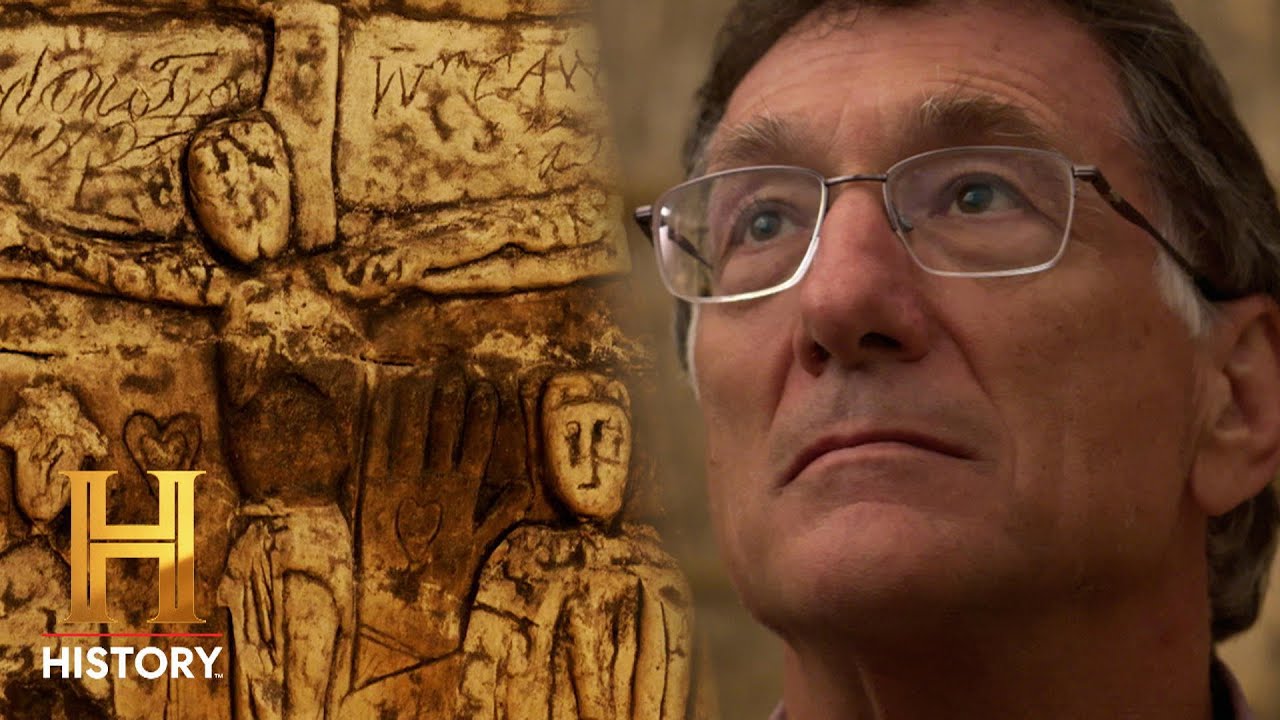
The Curse of Oak Island: Knights Templar Secrets Hidden in UK Cave (Season 10)
When Was Royston Cave Discovered?
In the year 1742, the hidden wonder of Royston Cave came to light through a stroke of serendipity. Workmen engaged in constructing foundations for the butter market above stumbled upon an unexpected treasure. As they unearthed a millstone from the ground, a vertical shaft was revealed, leading deep into the earth.
A courageous young boy, barely nine or ten years old, volunteered to explore the depths of the shaft. To his astonishment, he discovered a cave, buried beneath layers of earth and debris, roughly thirty feet below the surface. Rumors of treasure quickly spread, prompting a group of individuals to clear out the accumulated debris.
During the excavation, remarkable findings emerged, including carvings on the walls and the discovery of a human skull. Sadly, these original artifacts and the skull were lost shortly after their unearthing.
Intriguingly, prior to this discovery, no documentation or records alluded to the existence of the cave. This absence of historical evidence has only heightened the mystique surrounding Royston Cave, leaving historians and researchers perplexed for generations. Following the discovery, a new entrance was constructed, providing easier access to the cave.
What Are The Theories And Speculations In Royston Cave?
Royston Cave has sparked a plethora of theories regarding its purpose and creators. The most prevalent hypothesis suggests that the cave was employed by the Knights Templar, a religious and military order of monks active during the Middle Ages. As the Knights Templar had a presence in Hertfordshire and a stronghold in Baldock, it is plausible that they were involved in the construction of Royston Cave.
The persecution of the Knights Templar by Pope Clement V and King Philip IV of France in 1307 led many members to seek refuge underground, making the cave a potential safe haven for the order. Another theory proposes that the cave may have been utilized by King James I, who possessed ties to Freemasonry—an esoteric and secretive fraternity not fully understood at the time. It is conceivable that King James I utilized the cave for private rituals and practices.
Less common theories speculate that the cave served as a prison, a private chapel, or a dwelling place for a Saxon hermit. Some evidence suggests that the cave had multiple levels created by wooden platforms, and certain conjectures even propose the existence of underground walkways connecting the cave to a nearby church, although no conclusive evidence has been found to substantiate these claims.
What Are The Carvings In Royston Cave?
Descending down the steep walkway into Royston Cave, visitors are greeted by a sight that leaves them awestruck. The sheer depth below the ground evokes wonder, prompting contemplation of the means by which people once entered and exited this subterranean realm using ropes and ladders.
The cave's walls, a tapestry of carvings, immediately command attention with their intricate details. Each carving tells a story or represents a significant figure, inviting exploration and interpretation.
Among the most remarkable carvings is a depiction of Jesus' resurrection, accompanied by the hand of God—a powerful symbol of divine intervention. St. Katherine, holding a spiked wheel associated with her martyrdom, stands as a testament to her enduring legacy. Additionally, a line of thirteen figures believed to represent Jesus and his disciples adorns the cave.
One carving that enthralls visitors is that of St. Laurence, known as the Grail Saint. Legend holds that during the sack of Rome, St. Laurence safeguarded the cup used in the celebration of the Mass and carried it to Spain for safekeeping—a cup believed by some to be the Holy Grail, used by Jesus during the Last Supper.
While Christian carvings dominate, Royston Cave also boasts non-Christian symbols, such as a large horse and an Earth Goddess known as Sheela Na Gig. These symbols align with pagan beliefs and serve as representations of fertility. The presence of diverse carvings from different eras introduces a discrepancy in dating, further shrouding the origins of the cave in mystery.
What Are The Ley Lines In Royston Cave?
Many visitors to Royston Cave hold the belief that the cave lies at the convergence of the Michael and Mary ley lines. These ley lines are believed to be powerful channels of earth energy or electromagnetic pulses emitted by the planet, often associated with spiritual sites.
According to this belief, the strategic placement of spiritual sites along ley lines harnesses the potent energy for healing and spiritual purposes. The Michael and Mary lines, extending through locations like Glastonbury, Avebury, and St. Michael's Mount, allegedly infuse Royston Cave with an additional aura of spiritual significance.
Preserving A Fragile Legacy
Royston Cave poses unique challenges for conservation due to its composition of soft chalk, prone to degradation. Natural factors, such as water infiltration, contribute to the softening of the carvings, while cracks and fissures appear as a result of the drying and subsequent deterioration of the chalk.
Microbiological growth and the activity of worms further threaten the preservation of the carvings, highlighting the delicate nature of Royston Cave's conservation. Moreover, the absence of similar examples complicates the conservation efforts, requiring pioneering approaches to ensure the cave's survival. Researchers and scientists continuously examine the cave, striving to develop effective strategies, but the absence of a foolproof solution underscores the challenges of conserving this unique historical site.
Visiting Royston Cave
For those eager to experience the splendor of Royston Cave firsthand, a visit to this remarkable site is an absolute must. In the span of a brief sojourn, visitors can immerse themselves in a wealth of knowledge and discoverhidden facets of history and significant individuals.
We wholeheartedly recommend seizing the opportunity to embark on this extraordinary journey of exploration. Royston Cave promises to leave you utterly amazed, as it unveils secrets from centuries past and invites you to witness the remarkable beauty concealed beneath the streets of Royston.
As Royston guards its timeless secret, the allure of the enigmatic cave continues to deepen, leaving visitors and scholars captivated by its mysteries. Royston Cave stands as a testament to humanity's enduring fascination with the unknown, a testament that beneath the unassuming facade of even the humblest towns, remarkable treasures await those who dare to seek them.
People Also Ask
Why Is Royston Called Royston?
Royston derived its name from the original settlement's association with Roisia's Cross, which evolved over time from Crux Roheyes to Roisia's Town and eventually became known as Royston.
How Do You Pronounce Royston?

How to pronounce Royston (English/UK) - PronounceNames.com
What Famous People Are From Royston Herts?
Royston, Hertfordshire has been home to notable individuals including Helen Bailey, Alison Balsom, William Barrington-Coupe, Jack Bedwell, Robin Belfield, Danny Bryant, and Walter Byles.
Conclusion
In conclusion, Royston Cave is a remarkable underground cave discovered under Hertfordshire town streets. With its captivating carvings, centuries-old mysteries, and ongoing intrigue, this hidden gem beneath the town's surface continues to enthrall visitors and researchers alike.
Jump to
Underground Cave Discovered Under Hertfordshire Town Streets
What Is The History Of The Royston Cave?
When Was Royston Cave Discovered?
What Are The Theories And Speculations In Royston Cave?
What Are The Carvings In Royston Cave?
What Are The Ley Lines In Royston Cave?
Preserving A Fragile Legacy
Visiting Royston Cave
People Also Ask
Conclusion

Xander Oddity
Author
Xander Oddity, an eccentric and intrepid news reporter, is a master of unearthing the strange and bizarre. With an insatiable curiosity for the unconventional, Xander ventures into the depths of the unknown, fearlessly pursuing stories that defy conventional explanation. Armed with a vast reservoir of knowledge and experience in the realm of conspiracies, Xander is a seasoned investigator of the extraordinary.
Throughout his illustrious career, Xander has built a reputation for delving into the shadows of secrecy and unraveling the enigmatic. With an unyielding determination and an unwavering belief in the power of the bizarre, Xander strives to shed light on the unexplained and challenge the boundaries of conventional wisdom. In his pursuit of the truth, Xander continues to inspire others to question the world around them and embrace the unexpected.

Dr. Felix Chaosphere
Reviewer
Dr. Felix Chaosphere, a renowned and eccentric psychiatrist, is a master of unraveling the complexities of the human mind. With his wild and untamed hair, he embodies the essence of a brilliant but unconventional thinker. As a sexologist, he fearlessly delves into the depths of human desire and intimacy, unearthing hidden truths and challenging societal norms.
Beyond his professional expertise, Dr. Chaosphere is also a celebrated author, renowned for his provocative and thought-provoking literary works. His written words mirror the enigmatic nature of his persona, inviting readers to explore the labyrinthine corridors of the human psyche.
With his indomitable spirit and insatiable curiosity, Dr. Chaosphere continues to push boundaries, challenging society's preconceived notions and inspiring others to embrace their own inner tumult.
Latest Articles
Popular Articles
